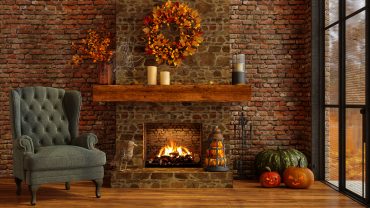In the early 1900s, architect Frank Lloyd Wright imagined homes that would mirror the endless horizons and natural beauty of the American Midwest. Departing from the ornate designs of the Victorian era, he sought to create structures that blended seamlessly with the landscape, emphasising horizontal lines and organic materials. His vision sparked an architectural movement known as prairie style; one that soon spread to prairie style interiors.
So, what exactly is prairie style interior design? How did this aesthetic emerge, and what are its defining features? We’re delving into the roots of this harmonious design philosophy, exploring its key characteristics, and uncovering how it continues to inspire modern interiors today.
History of Prairie Style Interiors

A rustic office in the prairie style (Credit: DougBennett via Getty Images)
The Prairie style originated in the United States during the late 19th and early 20th centuries, primarily in the Midwest. Frank Lloyd Wright, along with other architects known as the Prairie School, aimed to create an architectural style that was uniquely American, free from European influences. They developed designs that complemented the vast, flat expanses of the Midwestern landscape, embracing the horizontal lines and open spaces characteristic of the region.
The interiors of prairie style houses reflected this architectural philosophy. Wright believed that the inside of a home should mirror its exterior, creating a cohesive and unified aesthetic. This approach led to prairie style home interior design that was open, functional, and seamlessly connected to the outdoors. The use of natural materials and earthy colours further reinforced this connection, making the home feel like an integral part of the landscape.
Key Characteristics of Prairie Style Interiors

The horizontal lines and natural materials of prairie style interior design (Credit: jimkruger via Getty Images)
So, how does one bring the feel of the plains and grasslands into a home? Here are some of the main features of prairie style house interiors.
Open Floor Plans
One of the hallmarks of prairie style interiors is the open floor plan. Traditional compartmentalised rooms are replaced with expansive spaces that flow into one another without the interruption of walls or doors. Living rooms, dining areas, and kitchens are often integrated into a single, continuous space. This design not only enhances the sense of spaciousness but also encourages social interaction and communal living. The open floor plan allows for flexibility in furniture arrangement and facilitates the use of natural light, creating a bright and airy atmosphere.
Emphasis on Horizontal Lines
Prairie style interiors prominently feature horizontal lines, reflecting the flatness of the Midwestern plains. This is achieved through the use of long, low furniture pieces, extended roof eaves, and horizontal bands of windows. Even decorative elements such as mouldings, trim, and wall panelling emphasise horizontal direction. The horizontal emphasis creates a calming and grounding effect within the space, guiding the eye along the length of the rooms and reinforcing the connection to the landscape in prairie style house interiors.
Natural Materials
The use of natural materials is central to prairie style interior design. Wood, stone, brick, and glass are commonly used to bring warmth and texture to the interiors. These materials are often left in their natural state or minimally treated to showcase their inherent beauty. For instance, wood is typically used for flooring, wall panelling, and built-in furniture, highlighting the grain and natural variations of the material. Stone and brick may be used for fireplaces, columns, or accent walls, adding a rugged and organic feel to the space in prairie style house interiors.
Earthy Colour Palette
The colour palette in prairie style interiors draws inspiration from the natural surroundings. Warm earth tones such as browns, tans, muted greens, rusts, and ochres are predominant. These colours contribute to a soothing atmosphere and reinforce the connection to nature. Accents of deeper colours like burgundy or forest green may be used to add depth and interest. The overall effect is a harmonious and cohesive environment that feels both inviting and serene.
Built-In Furniture
Built-in furniture is a common feature in prairie style homes. This includes elements like bookcases, seating nooks, window seats, and cabinetry that are integrated into the architecture of the space. Built-ins enhance the functionality of the home while maintaining clean lines and minimising clutter. They’re often crafted from the same wood used elsewhere in the interior, creating a seamless and unified look. Built-in lighting, such as sconces or recessed fixtures, may also be incorporated to enhance the ambience without detracting from the simplicity of the design.
Stained Glass & Art Glass
Another distinctive feature of prairie style interiors is the use of stained glass or art glass windows. Frank Lloyd Wright often incorporated geometric patterns and abstract designs into windows, doors, and light fixtures. These decorative elements add colour and interest while allowing natural light to filter into the space in unique ways. The patterns often reflect natural motifs such as plants or abstract representations of the landscape, further integrating the design with its surroundings.
Influences and Inspirations

Japanese design has influenced the prairie style (Credit: Cavan Images via Getty Images)
Prairie style interior design is heavily influenced by the Arts and Crafts movement, which emphasised handcrafted workmanship, simplicity, and the use of natural materials. This movement was a reaction against the industrialisation and mass production of the late 19th century, advocating for a return to traditional craftsmanship and design integrity.
Interestingly, Japanese architecture also played a significant role in shaping prairie style interiors, particularly in the use of horizontal lines, open spaces, and a strong connection between indoor and outdoor environments. Frank Lloyd Wright was deeply influenced by Japanese design principles, incorporating elements such as wide overhangs, open floor plans, and minimalist aesthetics into his work.
The fusion of these influences resulted in interiors that are both aesthetically pleasing and highly functional, promoting a lifestyle that aims to remain in harmony with nature and emphasises quality over ornamentation.
Creating Modern Prairie Style Homes Interiors

A modern interpretation of prairie style interior design (Credit: PC Photography via Getty Images)
Incorporating prairie style elements into modern homes involves embracing the principles of simplicity, natural materials, and integration with the environment. This can be achieved through the selection of furniture with clean lines and low profiles, the use of natural materials like wood, stone, and glass, and the adoption of an open floor plan.
Modern prairie style home interiors may also incorporate sustainable design practices. This includes using locally sourced and environmentally friendly materials, implementing energy-efficient systems, and designing spaces that maximise natural light and ventilation. Green roofs, solar panels, and rainwater harvesting systems can be integrated into the design, aligning with the prairie style’s emphasis on harmony with nature.
In terms of décor, selecting textiles and accessories in earthy tones and natural fibres can enhance the prairie aesthetic. Artwork and decorative items that reflect natural motifs or abstract geometric patterns can add visual interest without overwhelming the simplicity of the design.
Anything But Plain

A harmonious integration with the environment (Credit: John Anthony Rizzo via Getty Images)
As we’ve seen, prairie style interior design strives for a timeless aesthetic that celebrates simplicity, craftsmanship, and a deep connection to nature. What’s more, its emphasis on natural materials, earthy colours, and harmonious integration with the environment makes it as relevant today as it’s ever been.












